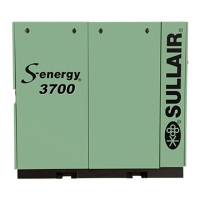2: Description 3000PB, 3700B, 4500B, 3000PVB, 3700VB, 4500VB User Manual
02250216-786 R01
12 Subject to EAR, ECCN EAR99 and related export control restrictions.
After the air/fluid mixture is discharged from the compres-
sor unit, the fluid is separated from the air. At this time,
the
air flows through an aftercooler and separator then to
your service line while the fluid is being cooled in prepa-
ration for reinjection.
2.4 Compressor cooling and lubrication
system, functional description
Refer to Figure 2-3 or Figure 2-4. The cooling and lubri-
cation system (air-cooled version) consists of a fan, fan
mo
tor, radiator-type aftercooler/fluid cooler, full flow fluid
filter, thermal valve, and interconnecting hoses. For
water-cooled models, two shell and tube heat exchang-
ers are substituted for the radiator-type cooler listed
a
bove. The pressure in the separator/sump tank causes
fluid flow by forcing the fluid from the high pressure area
of the separator/sump tank to an area of lower pressure
in the compressor unit.
Fluid flows from the bottom of the separator/sump tank to
the
thermal valve. The thermal valve is fully open when the
fluid temperature is below 185°F (85°C) [200°F (93°C) for
24KT
®
] and pressures are rated above 150 psig. The fluid
passes through the thermal valve, the main filter and
directly to the compressor unit where it lubricates, cools
and seals the rotors and the compression chamber.
As the discharge temperature rises above 185°F (85 °C),
d
ue to the heat of compression, the thermal valve begins
to adjust and a portion of the fluid then flows through the
cooler. From the cooler the fluid flows to the fluid filter
and then on to the compressor unit.
A portion of the fluid flowing to the compressor is routed
to the an
ti-friction bearings which support the rotors
inside the compressor unit.
The fluid filter has a replacement element
and an integral pres-
sure bypass valve. Refer to Section 3.7: Lubrication change
recommendations and maintenance, fluid o
n page 25.
Water-cooled models have a water pressure switch to
pr
event operation with inadequate water pressure.
2.5 Compressor discharge system,
functional description
Refer to Figure 2-3 or Figure 2-4. The compressor unit
discharges the compressed air/fluid mixture into the com-
bination separator/sump tank.
The separator/sump has three basic functions:
• It acts as a primary fluid separator.
•
Serves as the compressor fluid sump.
• Houses the final fluid separator.
The compressed air/fluid mixture enters the separator/
sump
tank and flows through an internal baffle system.
The direction of movement is changed and its velocity
significantly reduced, thus causing large droplets of fluid
to form and fall to the bottom of the separator/sump tank.
The fractional percentage of fluid remaining in the com-
pressed air collects on the surface of the separator ele-
ment as the compressed air flows through the separator.
A r
eturn line (or scavenge tube) leads from the dry side of
the separator/sump tank to a medium pressure region of
the compressor unit. Fluid collecting on the bottom of the
separator is returned to the compressor by a pressure
differential between the separator/sump and the com-
pressor. A visual sight glass is located on the return line
to o
bserve this fluid flow. There is also an orifice in this
return line (protected by a strainer) to assure proper flow.
A message on the controller indicates if abnormal pres-
sure drop through the separat
or develops. Refer to Sec-
tion 3.7: Lubrication change recommendations and
maintenance, fluid on
page 25.
A minimum pressure/check valve, located downstream
fro
m the separator, assures a minimum separator/sump
pressure of 50 psig (3.4 bar) during loaded conditions.
Th
is pressure is necessary for proper air/fluid separation
and proper fluid circulation.
A terminal check valve is incorp
orated into the minimum
pressure/check valve to prevent compressed air in the
service line from bleeding back into the separator/sump
on shutdown and during operation of the compressor in
an unloaded condition.
A pressure relief valve (located on the wet side of the
sep
arator) is set to open if the separator/sump tank pres-
sure exceeds the sep
arator/sump tank rating. The con-
troller will shut down the compressor if the discharge
temp
erature reaches 235°F (113°C).
Fluid is added to the separator/sump tank via a capped
fluid
filler opening, placed low on the tank to prevent
overfilling of the separator/sump tank. A sight glass
enables the operator to visually monitor the separator/
sump tank fluid level.
WARNING
Do not remove caps, plugs, and/or other com-
ponents when compressor is running or pressur-
ized. Stop compressor and relieve all internal
pr
essure before doing so.

